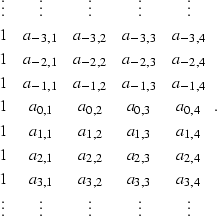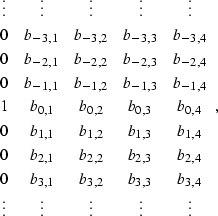




Next: Spurious event generation with
Up: Spurious event generation with
Previous: Spurious event generation with
As shown in Abma and Claerbout 1993
and in chapter ![[*]](http://sepwww.stanford.edu/latex2html/cross_ref_motif.gif) of this thesis,
the similarities and differences
between f-x prediction and t-x prediction
are explained by comparing the form of the
t-x prediction filter and the form of the effective t-x domain
filter created by f-x prediction.
This comparison,
which is also shown in chapter
of this thesis,
the similarities and differences
between f-x prediction and t-x prediction
are explained by comparing the form of the
t-x prediction filter and the form of the effective t-x domain
filter created by f-x prediction.
This comparison,
which is also shown in chapter ![[*]](http://sepwww.stanford.edu/latex2html/cross_ref_motif.gif) ,
is quickly reviewed here.
,
is quickly reviewed here.
For each frequency, f-x prediction generates a prediction filter
over the samples in space.
The individual filters calculated by the f-x prediction have the form
|  |
(72) |
where a1,a2,a3, and a4 are complex numbers.
Collecting these filters for all frequencies and presenting them in the
frequency-space domain produces the following composite filter:
|  |
(73) |
Transforming this filter from the frequency-space domain into the
time-space domain gives the effective t-x domain filter,
|  |
(74) |
where the number of rows is the number of time samples in the
data being considered, i.e. the design window.
The Fourier transform has converted the first column of 1s into
a single 1 at the output position,
creating a
time-space filter.
A typical t-x prediction filter appears as:
|  |
(75) |
This filter has
the same form as
the f-x prediction filter shown in (![[*]](http://sepwww.stanford.edu/latex2html/cross_ref_motif.gif) )
but with the number of rows greatly decreased.
The action of an f-x prediction filter can be seen to be the action
of a t-x prediction filter with a very long time-length.
)
but with the number of rows greatly decreased.
The action of an f-x prediction filter can be seen to be the action
of a t-x prediction filter with a very long time-length.





Next: Spurious event generation with
Up: Spurious event generation with
Previous: Spurious event generation with
Stanford Exploration Project
2/9/2001
![[*]](http://sepwww.stanford.edu/latex2html/cross_ref_motif.gif) of this thesis,
the similarities and differences
between f-x prediction and t-x prediction
are explained by comparing the form of the
t-x prediction filter and the form of the effective t-x domain
filter created by f-x prediction.
This comparison,
which is also shown in chapter
of this thesis,
the similarities and differences
between f-x prediction and t-x prediction
are explained by comparing the form of the
t-x prediction filter and the form of the effective t-x domain
filter created by f-x prediction.
This comparison,
which is also shown in chapter ![[*]](http://sepwww.stanford.edu/latex2html/cross_ref_motif.gif) ,
is quickly reviewed here.
,
is quickly reviewed here.


